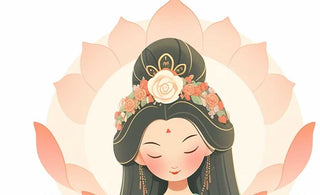
Introduction:
The lotus flower, revered for its symbolic significance in various cultures, holds a plethora of meanings that transcend its physical beauty. One intriguing aspect of lotus symbolism lies in the diverse spectrum of colors it can exhibit. This exploration delves into the hidden meanings associated with lotus flowers based on their colors, unraveling the profound symbolism behind each hue.
1.Pure White Lotus: Purity and Spiritual Perfection
The pure white lotus stands as an emblem of purity and spiritual perfection. In many spiritual traditions, this pristine blossom emerges from the mud, symbolizing the journey from darkness to enlightenment. The white lotus, untouched by the impurities of its surroundings, mirrors the soul's quest for transcendence beyond the material world. It signifies the attainment of spiritual purity amid life's challenges.
The symbolism of the pure white lotus transcends cultural and spiritual boundaries, embodying purity, spiritual perfection, and enlightenment. This pristine blossom emerges elegantly from the murky depths, untainted by the mud that nurtures its roots. Across numerous traditions and representations in art, the white lotus serves as a powerful metaphor for the human journey towards spiritual awakening.
In the realm of Eastern spirituality, the lotus holds profound significance. Within Buddhism, the white lotus represents the pristine nature of the Buddha himself. It signifies the purity of body, speech, and mind—attributes that the enlightened being embodies. Among the pantheon of Buddhist deities, Avalokiteśvara, the bodhisattva of compassion, is often depicted holding a white lotus, emphasizing compassion's pure and transcendent nature. The lotus in Avalokiteśvara's hand signifies the blossoming of compassion in the midst of the world's suffering, illustrating the possibility of attaining purity amidst the complexities of life.
In the revered sculptures and art pieces portraying the Three Saints of the West, the white lotus frequently accompanies Avalokiteśvara. This depiction symbolizes the bodhisattva's unwavering commitment to alleviating suffering, offering hope, and guiding individuals towards spiritual purity. These sculptures, crafted with intricate detail and precision, encapsulate the essence of purity and spiritual elevation, inviting viewers to contemplate the journey towards enlightenment.
Moreover, the journey depicted in the "Journey to the West" narrative, a beloved tale in Eastern literature, reflects the quest for spiritual awakening and purity. The characters' trials and tribulations parallel the human struggle against ignorance and the pursuit of spiritual perfection. Throughout the journey, the symbolism of the white lotus subtly permeates the narrative, representing the characters' aspirations for enlightenment amid the challenges they face.
The use of white jade marble in Oriental artistry further accentuates the purity and elegance of the lotus. This choice of material not only adds to the aesthetic appeal but also serves as a symbolic representation of the quest for spiritual purity. The craftsmen, through their skillful hands, carve and mold the marble into exquisite forms, breathing life into the symbolism of the lotus and its significance in spiritual evolution.
The white lotus's portrayal in these sculptures and artistic creations transcends mere aesthetic beauty; it serves as a reminder of humanity's inherent potential for spiritual transcendence. Amidst the complexities and uncertainties of life, these representations inspire individuals to seek purity, compassion, and enlightenment, despite the challenges posed by the world.
2.Radiant Red Lotus: Passion, Love, and the Heart's Desires
The vibrant red lotus carries connotations of passion, love, and the fulfillment of the heart's desires. Often associated with the emotions and the heart chakra, the red lotus symbolizes the fiery energy of love and compassion. Its blossoming petals evoke a sense of deep emotional connection, emphasizing the importance of cultivating love and compassion on the spiritual journey.
3.Mystical Blue Lotus: Wisdom and Knowledge
The mystical blue lotus is steeped in symbolism associated with wisdom and knowledge. Representing the victory of knowledge over ignorance, the blue lotus encourages seekers to embark on a journey of intellectual and spiritual enlightenment. It is a symbol of the mind's potential to overcome obstacles and attain higher states of consciousness, fostering the pursuit of wisdom in one's spiritual quest.
4.Elegant Pink Lotus: Grace, Femininity, and Compassion
The elegant pink lotus, with its soft and delicate hue, embodies qualities of grace, femininity, and compassion. This color is often associated with the goddesses in various cultural and spiritual traditions. The pink lotus encourages practitioners to embrace their softer, compassionate nature, fostering a harmonious balance between strength and gentleness on the spiritual path.
5.Mystifying Purple Lotus: Spirituality, Mysticism, and Transformation
The mystifying purple lotus holds profound symbolism related to spirituality, mysticism, and transformation. Its regal color signifies a connection to the divine and the unfolding of spiritual mysteries. The purple lotus encourages seekers to delve into the mystical realms of consciousness, facilitating personal transformation and spiritual evolution. It serves as a reminder that the spiritual journey is a continuous process of growth and discovery.
Conclusion:
In conclusion, the exploration of lotus flowers through the lens of color unveils a rich tapestry of hidden meanings. Each hue represents a facet of the human experience and the spiritual journey, providing practitioners with a visual language to express and understand profound concepts. Whether white, red, blue, pink, or purple, lotus flowers transcend mere aesthetic beauty, serving as powerful symbols that resonate with the deepest aspects of the human soul. By contemplating the hidden meanings behind lotus colors, individuals can find inspiration and guidance on their quest for spiritual growth and self-realization.
























